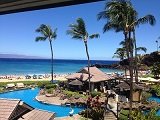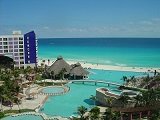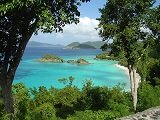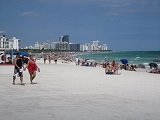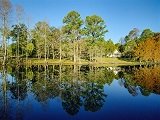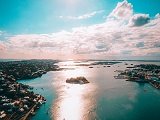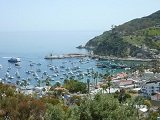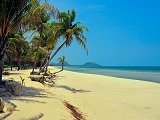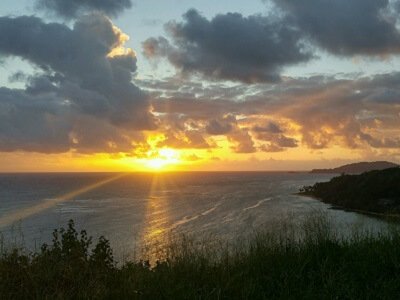- Home
- Hawaii Webcams
- Maui Webcams
- Weather
Search this site
Maui Weather Forecast
The Maui weather forecast varies greatly with location, even just a few miles. The small size of the island allows you the flexibility to
experience all the micro-climates, often in one day, while returning to
the one that you like the best for the majority of your stay.
Current Conditions and 7 day Maui Weather Forecast
KAANAPALI WEATHER
Maui Weather
Temperature by Month
Lahaina and the surrounding areas of Kaanapali, Kalapana and Napali all share similar weather and are only a few miles from each other.
The high temperatures in these areas are, on average, in the low to mid 80s year round. The cooler months are December through March with an average high temperature of 79 degrees. August and September are the warmest with average highs of 86 degrees. Seldom do high temperatures rise about 90 degrees. Low temperatures are the coolest between December and March with an average low of 66 to 69. All other months have lows in the 70 to 72 degree range. The all time record high was 98 and the low was 58.
Below are historical monthly average high and low temperatures for Maui's southwest side of the island. The weather for other locations may vary greatly in terms of cloud cover and rain but not so much in temperature.
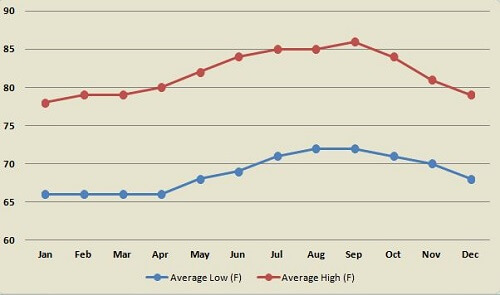 Lahaina Average High and Low Temperatures
Lahaina Average High and Low TemperaturesThe drier, most sunny and least amount of wind occurs on the northwest side of Maui in Lahaina, Kaanapali, Kapalua and Napali. The beaches in this area are the most clear and calm that you will find on the island and are ideal for swimming and snorkeling along shorelines and coves. The wind in this area blows offshore creating a calmer water. You will also see the best sunsets and afternoon rainbows, often at the same time, in this area. In my opinion, the best Maui Island vacations are on the calmer west side of the island.
The more windy and rainy northern side of the island is a favorite for board and wind surfers. This area has onshore winds making the seas more choppy but great for these activities.
Hint! - The closer you stay to Makena, the more likely your days will be cloudy between the hours of 9am and 4pm. Makena is on the southern side of 10,000 foot high Haleakala crater. As north to south trade winds blow up the slope, clouds condense and grow over Makena for the majority of the day. Temperatures are wonderful but if you like suntanning, this is not the area of the island for you.
Two miles northwest of Makena is Kihei. Here you loose the Makena cloud and enter an area that is less touristy and feels more like that small southern California beach community. Numerous open air flea markets often line the streets. There are no big fancy resorts here, Since Kihei sits directly in the valley between the two volcanoes, it is often very windy.
Rainfall by Month
The northwest side of the island is considered the "desert". Often showers come close but never reach these areas as the rain is squeezed out by the smaller of the two volcanoes directly to the north. This volcano also holds back the clouds. The rainy season for this area is between November and March with an average monthly rainfall total of 3.5 inches. December, on average, has the most rain. All other months generally see an average of about 1.5 inches of rain per month. Most rain showers in this area come and go quickly with bright sunshine returning immediately after a nice cooling shower. Overall I think that these areas have the best weather in Maui, lots of sunshine, leeward winds that make the ocean calmer and just enough rain and clouds to occasionally cool you off.
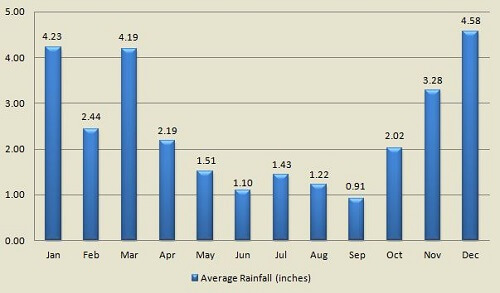 Lahaina Average Rainfall
Lahaina Average RainfallThe dry season is April through October with an average monthly rainfall of 3/4 of an inch. The rainy season of November through March has an average rainfall of about 2 3/4 inches per month.
More rain occurs on the Northeastern side of the island in towns such as Huelo, Keanae, Hana, Kipahulu and Kaupo where the influence of strong trade winds forced up the northern slope of Haleakala crater produce over 360 inches of rain in some areas. Getting an accurate Maui weather forecast for these areas is much more tricky in terms of predicting cloud cover, rain and wind and is often times over pessimistic.
Ocean Temperature by Month
The ocean water in Maui rarely ever gets below 75 degrees. Even in the winter, the water is warm. Unlike Caribbean locations where water temperatures can get into the mid to upper 80s, the ocean in Maui will not get much above 80 degrees and is always pleasant and refreshing.
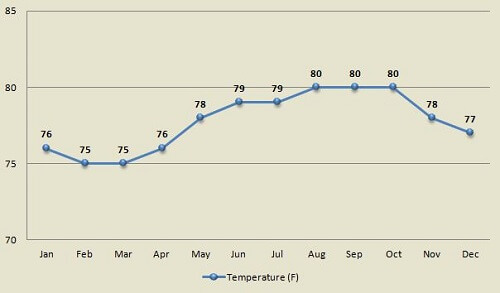 Maui Average Water Temperature
Maui Average Water TemperatureMaui Hurricanes
Most the time when you look at the Maui weather forecast, it will always be warm, breezy with an occasional shower. It seems like the Hawaiian islands are somewhat immune from direct hurricane hits despite being in the Pacific's hurricane highway, however it occasionally does happen. Most storms originate from the west coast of Mexico near the equator, travel to the Northwest and pass to the south of Hawaii. Maui has been affected by tropical storms and hurricanes several times but never received a direct hit. However, several major hurricanes have hit the island of Kauai, the most recent in September of 1992 where hurricane Iniki, a category 4 storm brought winds of 140 mph and killed six people.
Since 1949 there have been 38 hurricanes that have affected the weather in Hawaii but most passed to the South and were not direct hits. 22 of these occurred in September and October and many were during El Nino, a weather phenomena that pushes warm water west from Mexico and piles it up in the western Pacific only to have it move back to the east, towards the United States' west coast and northern Mexico.
